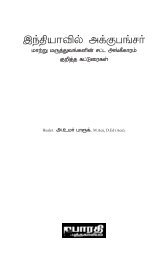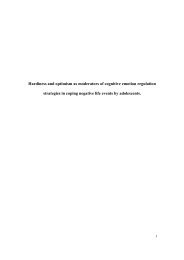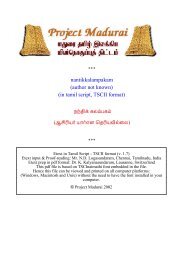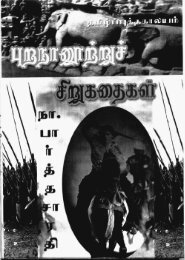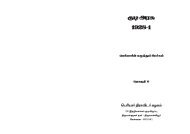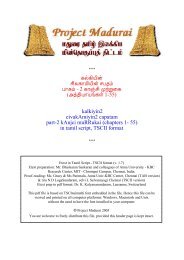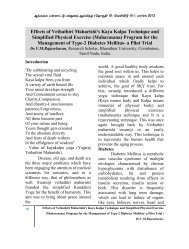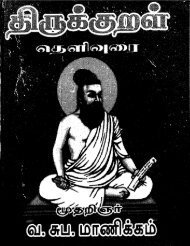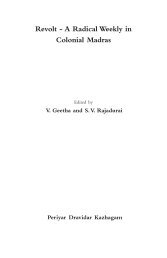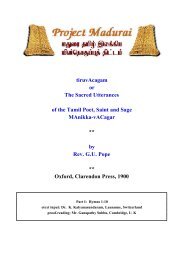National Conference on Ethical Issues and Indian Media
National Conference on Ethical Issues and Indian Media
National Conference on Ethical Issues and Indian Media
Create successful ePaper yourself
Turn your PDF publications into a flip-book with our unique Google optimized e-Paper software.
ati<strong>on</strong>al <str<strong>on</strong>g>C<strong>on</strong>ference</str<strong>on</strong>g> <strong>on</strong> <strong>Ethical</strong> <strong>Issues</strong> <strong>and</strong> <strong>Indian</strong> <strong>Media</strong> <strong>on</strong> ovember 26, 27 2010ati<strong>on</strong>al <str<strong>on</strong>g>C<strong>on</strong>ference</str<strong>on</strong>g><strong>on</strong><strong>Ethical</strong> <strong>Issues</strong> <strong>and</strong> <strong>Indian</strong> <strong>Media</strong>ovember 26-27 2010Organised byDept. of Journalism <strong>and</strong> Mass Communicati<strong>on</strong>,Periyar University, Salem<strong>and</strong>Associati<strong>on</strong> of Communicati<strong>on</strong> Teachers of Tamil adu <strong>and</strong> Puducherry (ACT-TP)Dept. of Journalism <strong>and</strong> Mass Communicati<strong>on</strong>, Periyar University, Salem
ati<strong>on</strong>al <str<strong>on</strong>g>C<strong>on</strong>ference</str<strong>on</strong>g> <strong>on</strong> <strong>Ethical</strong> <strong>Issues</strong> <strong>and</strong> <strong>Indian</strong> <strong>Media</strong> <strong>on</strong> ovember 26, 27 2010Periyar University was established by the Act 45 of Government of Tamil Nadu in 1997. The University is named after a renowned socialreformer popularly called "Thanthai Periyar". The University thus established had its origin with the three departments (Commerce, Geology <strong>and</strong>Mathematics) of Postgraduate extensi<strong>on</strong> center of Madras University functi<strong>on</strong>ing at Salem at that time. The University Grants Commissi<strong>on</strong>s, NewDelhi bestowed the 2f status <strong>on</strong> 09.10.1998 <strong>and</strong> 12(B) status <strong>on</strong> 17.05.2005 to the Periyar University. The university is certified accredited withNAAC.Visi<strong>on</strong>"Wisdom maketh world" is the visi<strong>on</strong> of Periyar University, as enshrined in the logo. This is based <strong>on</strong> the Philosophy of "Thanthai Periyar" inwhose name the University has been established, that man becomes man <strong>on</strong>ly through acquiring knowledge. This visi<strong>on</strong> aims at spreadingknowledge <strong>and</strong> quality educati<strong>on</strong> far <strong>and</strong> wide. The missi<strong>on</strong> of the University is to spread knowledge <strong>and</strong> skill in general <strong>and</strong> the thrust isparticularly given to enable the knowledge reach the youth of ec<strong>on</strong>omically, educati<strong>on</strong>ally <strong>and</strong> socially weaker secti<strong>on</strong>s. This missi<strong>on</strong> is achievedthrough the Departments of study <strong>and</strong> research of the University <strong>and</strong> its affiliated Colleges.The future of the nati<strong>on</strong> is in the h<strong>and</strong>s of the youth tomake this country self-reliant <strong>and</strong> self-sufficient <strong>and</strong> the youth has to be trained educati<strong>on</strong>ally. The enlightenment of knowledge <strong>and</strong> qualityeducati<strong>on</strong> given to the youth will be helpful to achieve this target. In the directi<strong>on</strong> of nati<strong>on</strong> building process, this University aims to uplift thesociety through educati<strong>on</strong> to attain self-reliance.Locati<strong>on</strong>The University is situated <strong>on</strong> the Bangalore <str<strong>on</strong>g>Nati<strong>on</strong>al</str<strong>on</strong>g> Highways (NH - 47), 10km from the Salem city <strong>and</strong> easily c<strong>on</strong>nected by road. The Universitycampus extends to about 100 acres accommodating the administrative <strong>and</strong> department buildings.The Department of Journalism <strong>and</strong> Mass Communicati<strong>on</strong> was established in the year 2008. At present <strong>on</strong>e Professor, <strong>on</strong>eAssociate professor <strong>and</strong> four Assistant Professors are working in the department. The department offer M.Sc., (VisualCommunicati<strong>on</strong>), M.A., M.Phil., Ph.D in Journalism <strong>and</strong> Mass Communicati<strong>on</strong>.Dept. of Journalism <strong>and</strong> Mass Communicati<strong>on</strong>, Periyar University, Salem
ati<strong>on</strong>al <str<strong>on</strong>g>C<strong>on</strong>ference</str<strong>on</strong>g> <strong>on</strong> <strong>Ethical</strong> <strong>Issues</strong> <strong>and</strong> <strong>Indian</strong> <strong>Media</strong> <strong>on</strong> ovember 26, 27 2010Dept. of Journalism <strong>and</strong> Mass Communicati<strong>on</strong>, Periyar University, Salem
ati<strong>on</strong>al <str<strong>on</strong>g>C<strong>on</strong>ference</str<strong>on</strong>g> <strong>on</strong> <strong>Ethical</strong> <strong>Issues</strong> <strong>and</strong> <strong>Indian</strong> <strong>Media</strong> <strong>on</strong> ovember 26, 27 2010ORGANISING COMMITTEEPatr<strong>on</strong>Prof K MuthuchelianVice ChancellorPeriyar University<str<strong>on</strong>g>C<strong>on</strong>ference</str<strong>on</strong>g> DirectorDr V NatarajanProfessor& HeadOrganizing SecretariesDr S N<strong>and</strong>akumarAssociate ProfessorDr G Balasubramaniya RajaAssistant ProfessorDr M AnuradhaAssistant ProfessorDr R SubramaniAssistant ProfessorThiru Maa ThamizhpparithiAssistant ProfessorACT-T P omineesProf G Ravindran, University of MadrasProf P Govindraju , M S UniversityDr P E Thomas, Bharathiyar UniversityDr S Arulselvan, P<strong>on</strong>dicherry UniversityMr Leo Fern<strong>and</strong>o, University of MadrasDept. of Journalism <strong>and</strong> Mass Communicati<strong>on</strong>, Periyar University, Salem
ati<strong>on</strong>al <str<strong>on</strong>g>C<strong>on</strong>ference</str<strong>on</strong>g> <strong>on</strong> <strong>Ethical</strong> <strong>Issues</strong> <strong>and</strong> <strong>Indian</strong> <strong>Media</strong> <strong>on</strong> ovember 26, 27 2010ati<strong>on</strong>al <str<strong>on</strong>g>C<strong>on</strong>ference</str<strong>on</strong>g> <strong>on</strong><strong>Ethical</strong> <strong>Issues</strong> <strong>and</strong> <strong>Indian</strong> <strong>Media</strong>ovember 26-27, 2010FIAL PROGRAMME SCHEDULEDay 1 – ovember 26, 2010Time8.30 – 9.00 am Registrati<strong>on</strong>9.00-10.45 am Inaugurati<strong>on</strong>9.00 – 9.10 am Welcome address Dr.V.atarajan, Prof. & Head, DJMC, PU-<str<strong>on</strong>g>C<strong>on</strong>ference</str<strong>on</strong>g> Director9.11-9.40am Presidential address (Chief Guest) Dr. K.Muthuchelian, Vice-Chancellor, PeriyarUniversity9.41– 10.40 am Keynote Address-1"<strong>Ethical</strong>ly Speaking: Truth in Business <strong>and</strong><strong>Media</strong>".10.41-10.45 am Vote of Thanks10.46-11.00 am Tea Break11.01 – 1.00 pm Sessi<strong>on</strong> – 1A News vs Paid NewsChairpers<strong>on</strong>: Dr.C.Pich<strong>and</strong>y, Head Dept. ofCommunicati<strong>on</strong>, PSG Arts <strong>and</strong> Science College,Coimbatore.11.00-12.30pmPaper <strong>and</strong> Presenters:Prof.Artemis PreeshlLoyola University, New Orleans, USA.Sessi<strong>on</strong> – 1B – <strong>Ethical</strong> <strong>Issues</strong> in OnlineJournalismChairpers<strong>on</strong>: Dr.P.Govindaraju, Prof <strong>and</strong> Head,Dept. of Communicti<strong>on</strong>, Man<strong>on</strong>maniam SundaranarUniversity, Tirunelveli.Paper <strong>and</strong> presenters1. Paid ews: A Message to Readers -LakshmiL Lund, Research Scholar (PhD) &Dr.P.E.Thomas, Associate Professor <strong>and</strong> Head,Dept. of Communicati<strong>on</strong> <strong>and</strong> <strong>Media</strong>Studies,Bharathiar University,CoimbatoreDept. of Journalism <strong>and</strong> Mass Communicati<strong>on</strong>, Periyar University, Salem1.Interactivity in Online Journalism: A Poser toEthics?- M. Shuaib Mohamed Haneef, AssistantProfessor, Dept. of Mass Communicati<strong>on</strong>, P<strong>on</strong>dicherryUniversity, Puducherry.
ati<strong>on</strong>al <str<strong>on</strong>g>C<strong>on</strong>ference</str<strong>on</strong>g> <strong>on</strong> <strong>Ethical</strong> <strong>Issues</strong> <strong>and</strong> <strong>Indian</strong> <strong>Media</strong> <strong>on</strong> ovember 26, 27 20102.Decoding Paid ews – Dr. Pitabas Pradhan,Assistant Professor, Dept. of MassCommunicati<strong>on</strong>, Aligarh Muslim University,Aligarh3. Paid ews <strong>and</strong> the PCI Report –Dr.C.Jebakumar, Assistant Professor, Dept. ofVisual Communicati<strong>on</strong>, SRM Arts SciecneCollege, Kattangulathur, Chennai4.What Bangalore Students Think About Paidews -B.Raja, Assistant Professor, <str<strong>on</strong>g>Nati<strong>on</strong>al</str<strong>on</strong>g> Institute ofFashi<strong>on</strong> Technology, Bangalore.5. How to Curb Paid ews?- Dr.RavindraChincholkar, Dept. of Mass Communicati<strong>on</strong>,Sholapur University, Maharashtra.6.‘vinaiseithiyum virppanai seithiyum-Thamizhaga seithikalaththil oru Ayivu-R.Malaramudan, Journalist, Chennai.2.Online Journalism <strong>and</strong> the Influence of ScienceProgrammes <strong>on</strong> College Students -Dr.P.E.Thomas,Associate Professor <strong>and</strong> Head-Dr.M.Sri Hari,Assistant Professor, Dept. ofCommunicati<strong>on</strong> <strong>and</strong> <strong>Media</strong> Studies, BharathiarUniversity, Coimbatore & M.Vijayalakshmi, AssistantProfessor, Dept. of <strong>Media</strong> Studies, KarunyaUniversity, Coimbatore3.Credibility of Health Informati<strong>on</strong> in Web SearchResults - Archana Vasudev, Research Scholar (MPhil)Dept. of Journalism <strong>and</strong> Communicati<strong>on</strong>, University ofMadras, Chennai.4. <strong>Ethical</strong> Dimensi<strong>on</strong>s of Online Journalism -K.S.Hampesh, Assistant Profesor, Dept. of MassCommunicati<strong>on</strong> <strong>and</strong> Journalism,SDM College, UjireKarnataka.5. <strong>Ethical</strong> <strong>Issues</strong> in Online Journalism - G.SureshKumar, Research Scholar (MPhil) & Dr.M.Sri Hari,Assistant Professor, Dept. of Communicati<strong>on</strong> <strong>and</strong><strong>Media</strong> Studies, Bharathiar University, Coimbatore6.Readers' Percepti<strong>on</strong>s of Online ewspapers - C TShruthi Devi, Research Scholar (MPhil) &Dr.P.E.Thomas,Associate Professor <strong>and</strong> Head Dept. ofCommunicati<strong>on</strong> <strong>and</strong> <strong>Media</strong> Studies, BharathiarUniversity, CoimbatoreDept. of Journalism <strong>and</strong> Mass Communicati<strong>on</strong>, Periyar University, Salem
ati<strong>on</strong>al <str<strong>on</strong>g>C<strong>on</strong>ference</str<strong>on</strong>g> <strong>on</strong> <strong>Ethical</strong> <strong>Issues</strong> <strong>and</strong> <strong>Indian</strong> <strong>Media</strong> <strong>on</strong> ovember 26, 27 20107.Online Journalism <strong>and</strong> Students in UniversitiesN. Raja, Assistant Professor, Dept. of VisualCommunicati<strong>on</strong>, Sathyabama University, Chennai12.30-1.00pm Discussi<strong>on</strong> <strong>and</strong> Q&A for sessi<strong>on</strong>-1A Discussi<strong>on</strong> <strong>and</strong> Q&A for sessi<strong>on</strong>-1B1.00-2.00pm Lunch Break2.00 – 4.00 pm Sessi<strong>on</strong> – 2A What Ails Televisi<strong>on</strong>Journalism?Chairpers<strong>on</strong>:Dr.S.Arulselvan, AssociateProfessor <strong>and</strong> Head, Dept. of Electr<strong>on</strong>ic <strong>Media</strong>,P<strong>on</strong>dicherry Universtiy, Puducherry.2.00 – 3.30 pm Paper <strong>and</strong> Presenters:1.Unethical Televisi<strong>on</strong> Reality Shows: A CaseStudy of Gudiya From Feminist Perspective -Mallika Vijaya Kumar, Research Scholar (PhD),& Dr. P.E.Thomas, Associate Professor <strong>and</strong>Head,Dept. of Communicati<strong>on</strong> <strong>and</strong> <strong>Media</strong>Studies,Bharathiar University, Coimbatore2.Trends in Kannada Televisi<strong>on</strong> ews -Krishna, Research Scholar, Bangalore.3.Do Carto<strong>on</strong> Programmes Teach <strong>Ethical</strong>lyRight Stories to Children? - N.S.Kannan,Research Scholar (PhD), Dept. of Journalism<strong>and</strong> Mass Communicati<strong>on</strong>, Periyar University,Salem.4. Health Shows in Tamil Televisi<strong>on</strong>-Deivasree Anbu - Research Scholar (PhD) -Dept. of Journalism <strong>and</strong> Mass Communicati<strong>on</strong>, Periyar University, SalemSessi<strong>on</strong> – 2B Invasi<strong>on</strong> of Privacy <strong>and</strong> Other<strong>Ethical</strong> Violati<strong>on</strong>sChairpers<strong>on</strong>:Dr.P.E.Thomas, Associate Professor<strong>and</strong> Head, Department of Communicati<strong>on</strong> <strong>and</strong> <strong>Media</strong>Studies, Bharathiyar University, Coimbatore.Paper <strong>and</strong> Presenters:1.Unethical Representati<strong>on</strong>s of Victims in Tamilewspapers - S.Aruneswari, Research Scholar(MPhil), Dept. of Journalism <strong>and</strong> Communicati<strong>on</strong>University of Madras, Chennai.2.<strong>Indian</strong> <strong>Media</strong>'s Coverage of Wikileaks <strong>on</strong> Iraq:An <strong>Ethical</strong> Perspective - K.Karnamaharajan,Associate Professor <strong>and</strong> Head, Dept. of Journalism <strong>and</strong>Mass Communicati<strong>on</strong>, Krishna University,Machilipatnam. & P.Prema Nair, Assistant Professor,Dept. of Visual Communicati<strong>on</strong>, AvinashilingamDeemed University, Coimbatore.3.Coimbatore Bomb Blasts: <strong>Ethical</strong> Violati<strong>on</strong>s byati<strong>on</strong>al <strong>and</strong> Local <strong>Media</strong> - C.R.Jayaprakash,Assistant Professor, Dept. of Communicati<strong>on</strong>, PSGCollege of Arts <strong>and</strong> Science, Coimbatore. &Dr.P.E.Thomas, Associate Professor <strong>and</strong> Head, Dept.of Communicati<strong>on</strong> <strong>and</strong> <strong>Media</strong> Studies, Bharathiar
ati<strong>on</strong>al <str<strong>on</strong>g>C<strong>on</strong>ference</str<strong>on</strong>g> <strong>on</strong> <strong>Ethical</strong> <strong>Issues</strong> <strong>and</strong> <strong>Indian</strong> <strong>Media</strong> <strong>on</strong> ovember 26, 27 2010Day 2 – ovember 27, 20109.00am -10.00 am Key note address-2"Filmmaking 'Praxis':Looking Back <strong>and</strong> Ahead <strong>on</strong>Ethics <strong>and</strong> Fears through the DocumentaryExperiences."10.30 am -12.30 pm Sessi<strong>on</strong> – 4A The Kantian/Thiruvalluvar'sPhilosophy of Ethics <strong>and</strong> <strong>Media</strong>Chairpers<strong>on</strong>:Dr.D.Bhoopathy, Associate Professor,Dept. of Communicati<strong>on</strong>, PSG College of Arts <strong>and</strong>Science Coimbatore.10.00-12.00 no<strong>on</strong> Paper <strong>and</strong> Presenters:1. A De<strong>on</strong>tological Evaluati<strong>on</strong> of Paid ews –Dr.S.Nagarathinam, Dinamalar,Madurai.2.<strong>Ethical</strong> Resp<strong>on</strong>sibilities of <strong>Media</strong> - B.Anitha,Assistant Professor, Dept.of Communicati<strong>on</strong>,Hindustan College of Arts <strong>and</strong> Science, Coimbatore. &Dr.V.Natarajan, Professor Head, Dept of Journalism<strong>and</strong> Mass Communicati<strong>on</strong>, Periyar University, Salem.3. Western <strong>and</strong> Eastern Approaches to <strong>Media</strong>Ethics - Janet Mary, Assistant Professor, Dept. ofVisual Communicati<strong>on</strong>, Sathyabama University,Chennai.4.Thiruvalluvar's Moral Philosophy <strong>and</strong> <strong>Media</strong>Ethics - M. Devendran, Assistant Professor,Department of Visual Communicati<strong>on</strong>, SRM Arts <strong>and</strong>Science College, Kattankulathur, Chennai.Dept. of Journalism <strong>and</strong> Mass Communicati<strong>on</strong>, Periyar University, SalemMr Marc Huraux, Independent Filmmaker(Morgane,Paris,France).Sessi<strong>on</strong> – 4B The <strong>Ethical</strong> Violati<strong>on</strong>sin Tamil Popular CultureChairpers<strong>on</strong>:Dr.Shantha, Prof <strong>and</strong>Head, Dept ofJournalism <strong>and</strong> ScienceCommunicati<strong>on</strong>, Madurai KamarajUniversity, Madurai.Paper <strong>and</strong> Presenters:1.Influence of Animati<strong>on</strong> <strong>on</strong>Preferences for Animati<strong>on</strong>-relatedCultural Goods -M.Anuradha, AssistantProfessor, Dept of Journalism <strong>and</strong> MassCommunicati<strong>on</strong>, Periyar University,Salem.2.Fan Clubs <strong>and</strong> Tamil Film Stars -C.Sadishkumar, Assistant Professor, Dept.of Communicati<strong>on</strong>, Dr.G.R.DamodaranCollege of Science, Coimbatore. &V.Natarajan, Professor Head, Dept ofJournalism <strong>and</strong> Mass Communicati<strong>on</strong>,Periyar University, Salem.3.Gender, Ethics <strong>and</strong> AdoorGopalakrishnan's Films - K.PradeepKumar, Assistant Professor, Dept.of
ati<strong>on</strong>al <str<strong>on</strong>g>C<strong>on</strong>ference</str<strong>on</strong>g> <strong>on</strong> <strong>Ethical</strong> <strong>Issues</strong> <strong>and</strong> <strong>Indian</strong> <strong>Media</strong> <strong>on</strong> ovember 26, 27 20105.Philosophical <strong>and</strong> <strong>Ethical</strong> Dimensi<strong>on</strong>s ofJournalism - Jojan Job, Assistant Professor, Dept. ofJournalism, Madras Christian College, Chennai.Visual Communicati<strong>on</strong>, Muslim ArtsCollege, Thiruvidhankode, Kanyakumari.4.Central Board of Film Certificati<strong>on</strong>:A Review- R.Rajesh, Assistant ProfessorDept. of Visual Communicati<strong>on</strong>, SRMUniversity, Kattangulathur, Chennai.6. ‘Thiruvalluvarin araneripparvaiyum TharkkalaEthazhkalum’. – Arokia Sakayaraj, Research Scholar(M.Phil), Dept. of Journalism <strong>and</strong> Communicati<strong>on</strong>,University of Madras, Chennai.7. Code of ethics in the ancient Tami Literature-Tirukkural – Dr. R.Subramani, Assistant Professor,Dept. of Journalism <strong>and</strong> Mass Communicati<strong>on</strong>, PeriyarUniversity, Salem.5. Influence of 3D Animated charactersin Tamil Films - Dr.An<strong>and</strong> LeninVethanayagam, Associate Professor,Centre for Electr<strong>on</strong>ic <strong>Media</strong>, P<strong>on</strong>dicherryUniversity, Puducherry & A.Vijayakumar,Research Scholar, Karunya University,Coimbatore.6. <strong>Ethical</strong> Violati<strong>on</strong>s in Print <strong>Media</strong>Advertisements - Maa. Thamizhpparithi,Assistant Professor, Department ofJournalism <strong>and</strong> Mass Communicati<strong>on</strong>,Periyar University, Salem-1112.00 – 12.30pm Discussi<strong>on</strong> <strong>and</strong> Q & A for Sessi<strong>on</strong> -4A Discussi<strong>on</strong> <strong>and</strong> Q & A for Sessi<strong>on</strong> -4B12.30-2.00pmLunch2.00-3.00 pm Sessi<strong>on</strong> – 5A Caste, Religi<strong>on</strong> <strong>and</strong> Other Markersof C<strong>on</strong>flicts of Interests in JournalismChairpers<strong>on</strong>:Dr.A.Ashok Kumar, Professor, Dept. ofElectr<strong>on</strong>ic <strong>Media</strong>, Bangalore University.Paper <strong>and</strong> Presenters:Sessi<strong>on</strong> – 5B What Ails <strong>Indian</strong> <strong>Media</strong>:Political Ownership or CorporateOwnership?Chairpers<strong>on</strong>:Dr..Mathiyalagan,Associate Professor, Dept. ofCommunicati<strong>on</strong> , PSG College of Arts <strong>and</strong>Science, Coimbatore.Paper <strong>and</strong> Presenters:1.Portrayal of Muslims in Dinamani <strong>and</strong> TheHindu- M.P.Ameerul Hasan, Research Scholar (PhD),Dept. of Journalism <strong>and</strong> Mass Communicati<strong>on</strong>, Periyar University, Salem1.<strong>Media</strong> Ethics <strong>and</strong> Recent Trends inElectr<strong>on</strong>ic <strong>Media</strong>- Shashi Bhushan Singh
ati<strong>on</strong>al <str<strong>on</strong>g>C<strong>on</strong>ference</str<strong>on</strong>g> <strong>on</strong> <strong>Ethical</strong> <strong>Issues</strong> <strong>and</strong> <strong>Indian</strong> <strong>Media</strong> <strong>on</strong> ovember 26, 27 2010Dept. of Journalism <strong>and</strong> Mass Communicati<strong>on</strong>, PeriyarUniversity, Salem.2.Journalists vs PR Practiti<strong>on</strong>ers in <strong>Indian</strong> PR BlogK.Rajesh Kumar - Research Scholar (MPhil), Dept. ofJournalism <strong>and</strong> Communicati<strong>on</strong>, University of Madras,Chennai3.The Under Representati<strong>on</strong> of Dalits in JournalismJ.Balasubramaniam, Assistant Professor, Dept. ofJournalism <strong>and</strong> Science Communicati<strong>on</strong>, MaduraiKamaraj University,Madurai.4. The Big Picture-A c<strong>on</strong>tent analysis <strong>on</strong> violati<strong>on</strong> ofmedia ethics – Rachel Jacob, Assistant Professor,MCC, Chennai.School of Literature, Mahatma G<strong>and</strong>hiInternati<strong>on</strong>al Hindi University, Wardha,Maharashtra.2. 24/7 Kannada ews Channels:Linkages Between Ownership <strong>and</strong>C<strong>on</strong>tent -Sunil, Assistant Professor,Symbiosis Institute of <strong>Media</strong> <strong>and</strong>Communicati<strong>on</strong>, Symbiosis Internati<strong>on</strong>alUniversity, Bangalore.3. Ethics <strong>and</strong> Cross <strong>Media</strong> ownership –Dr.S.N<strong>and</strong>akumar, Associate Professor,Dept. of Journalism <strong>and</strong> MassCommunicati<strong>on</strong>, Periyar University,Salem.4.What Ails Televisi<strong>on</strong> Journalism? –Dr.M.S.Sapna, Assistant Professor,Dept.of Mass Communicati<strong>on</strong> <strong>and</strong>Journalism, University of Mysore,Mysore.3.00-3.30pm Discussi<strong>on</strong> <strong>and</strong> Q & A for Sessi<strong>on</strong> -5A Discussi<strong>on</strong> <strong>and</strong> Q & A for Sessi<strong>on</strong> – 5B3.30-3.45pm3.45-5.30pmTea BreakRound Table Discussi<strong>on</strong> <strong>and</strong> c<strong>on</strong>cluding remarks <strong>and</strong> Certificate distributi<strong>on</strong>Chairpers<strong>on</strong>:Dr.G.Ravindran5.30-7.00pmACT-TP Business MeetingDept. of Journalism <strong>and</strong> Mass Communicati<strong>on</strong>, Periyar University, Salem
ati<strong>on</strong>al <str<strong>on</strong>g>C<strong>on</strong>ference</str<strong>on</strong>g> <strong>on</strong> <strong>Ethical</strong> <strong>Issues</strong> <strong>and</strong> <strong>Indian</strong> <strong>Media</strong> <strong>on</strong> ovember 26, 27 201026.11.2010Sessi<strong>on</strong> IANews vs Paid News11.00 am – 1.00 pmPaid ews: A Message to ReadersLakshmi L LundResearch Scholar (PhD)Dept. of Communicati<strong>on</strong> <strong>and</strong> <strong>Media</strong> StudiesBharathiar UniversityCoimbatoreP.E.ThomasAssociate Professor <strong>and</strong> HeadDept. of Communicati<strong>on</strong> <strong>and</strong> <strong>Media</strong> StudiesBharathiar UniversityCoimbatoreAbstractIn recent years, the phenomen<strong>on</strong> of paid news has acquired a new <strong>and</strong> pernicious dimensi<strong>on</strong> in the sphere of political news. Inthe financial reporting sector, private treaties between media houses <strong>and</strong> the corporate organizati<strong>on</strong>s are <strong>on</strong> the rise. All this hasgiven birth to ‘rate cards’ <strong>and</strong> ‘packages,’ which in lay man's language means a ‘menu card’ of the price tags attached to thecoverage the individual or corporate entity receives from the media house. The aim of this paper is to c<strong>on</strong>vey a message t<strong>on</strong>ewspaper readers that time has come to know about the media, rather than knowing from the media.Dept. of Journalism <strong>and</strong> Mass Communicati<strong>on</strong>, Periyar University, Salem
ati<strong>on</strong>al <str<strong>on</strong>g>C<strong>on</strong>ference</str<strong>on</strong>g> <strong>on</strong> <strong>Ethical</strong> <strong>Issues</strong> <strong>and</strong> <strong>Indian</strong> <strong>Media</strong> <strong>on</strong> ovember 26, 27 2010Decoding Paid ewsDr Pitabas PradhanAssistant ProfessorDept. of Mass Communicati<strong>on</strong>Aligarh Muslim UniversityAligarhAbstractThe most deep-seated ethical can<strong>on</strong> of journalism ought to be providing objective news to readers. What happens when the distincti<strong>on</strong>between news <strong>and</strong> advertisements starts blurring, when advertisements are duped up as news that have been paid for, or when ‘news’is published in favour of a particular politician by selling editorial space? The media’s growing tendency of compromising theeditorial space through paid news dilutes its professi<strong>on</strong>al missi<strong>on</strong> as the c<strong>on</strong>science keeper of the society. In the c<strong>on</strong>text of the growingincidents of paid news, this paper attempts to decode the phenomen<strong>on</strong> of paid news in terms of its historical, operati<strong>on</strong>al, legal, <strong>and</strong>moral aspects.Dept. of Journalism <strong>and</strong> Mass Communicati<strong>on</strong>, Periyar University, Salem
ati<strong>on</strong>al <str<strong>on</strong>g>C<strong>on</strong>ference</str<strong>on</strong>g> <strong>on</strong> <strong>Ethical</strong> <strong>Issues</strong> <strong>and</strong> <strong>Indian</strong> <strong>Media</strong> <strong>on</strong> ovember 26, 27 2010Paid ews <strong>and</strong> the PCI ReportC.JebakumarAssistant ProfessorDept. of Visual Communicati<strong>on</strong>SRM Arts Sciecne CollegeKattangulathurChennaiAbstractThe phenomen<strong>on</strong> of paid news has become pervasive, structured <strong>and</strong> highly organized. Large secti<strong>on</strong>s of society have alreadyexpressed their unhappiness <strong>and</strong> c<strong>on</strong>cern about the pernicious influence of such malpractices. This paper examines the implicati<strong>on</strong>s ofpaid news in the c<strong>on</strong>text of the draft report prepared by Press Council of India <strong>on</strong> April 2010.Dept. of Journalism <strong>and</strong> Mass Communicati<strong>on</strong>, Periyar University, Salem
ati<strong>on</strong>al <str<strong>on</strong>g>C<strong>on</strong>ference</str<strong>on</strong>g> <strong>on</strong> <strong>Ethical</strong> <strong>Issues</strong> <strong>and</strong> <strong>Indian</strong> <strong>Media</strong> <strong>on</strong> ovember 26, 27 2010Dept. of Journalism <strong>and</strong> Mass Communicati<strong>on</strong>, Periyar University, Salem
ati<strong>on</strong>al <str<strong>on</strong>g>C<strong>on</strong>ference</str<strong>on</strong>g> <strong>on</strong> <strong>Ethical</strong> <strong>Issues</strong> <strong>and</strong> <strong>Indian</strong> <strong>Media</strong> <strong>on</strong> ovember 26, 27 2010What Bangalore Students Think About Paid ewsB.RajaAssistant Professor<str<strong>on</strong>g>Nati<strong>on</strong>al</str<strong>on</strong>g> Institute of Fashi<strong>on</strong> TechnologyBangaloreAbstractThe phenomen<strong>on</strong> of paid news has become pervasive, structured <strong>and</strong> highly organized <strong>and</strong> is undermining democracy in India. Largesecti<strong>on</strong>s of society, including political pers<strong>on</strong>alities, those working in the media <strong>and</strong> others, have already expressed their unhappiness<strong>and</strong> c<strong>on</strong>cern about the pernicious influence of such malpractices. The study aims to examine the awareness levels of students withreference to the phenomen<strong>on</strong> of paid news.Dept. of Journalism <strong>and</strong> Mass Communicati<strong>on</strong>, Periyar University, Salem
ati<strong>on</strong>al <str<strong>on</strong>g>C<strong>on</strong>ference</str<strong>on</strong>g> <strong>on</strong> <strong>Ethical</strong> <strong>Issues</strong> <strong>and</strong> <strong>Indian</strong> <strong>Media</strong> <strong>on</strong> ovember 26, 27 2010How to Curb Paid ews?Dr Ravindra ChincholkarDept. of Mass Communicati<strong>on</strong>Sholapur UniversityMaharashtraAbstractPaid news is not new for media, it has been a regular practice of newspapers in the name of special supplements, advertorials orprivate treaties between newspapers <strong>and</strong> corporate houses since 1980. Many a time, readers are unaware about the paid c<strong>on</strong>tent in thenewspapers. Misleading c<strong>on</strong>tent is a serious crime of media against every citizen. The present paper argues the case of effectivemeasures to curb paid news.Dept. of Journalism <strong>and</strong> Mass Communicati<strong>on</strong>, Periyar University, Salem
ati<strong>on</strong>al <str<strong>on</strong>g>C<strong>on</strong>ference</str<strong>on</strong>g> <strong>on</strong> <strong>Ethical</strong> <strong>Issues</strong> <strong>and</strong> <strong>Indian</strong> <strong>Media</strong> <strong>on</strong> ovember 26, 27 2010Sessi<strong>on</strong> IB11.00 am – 1.00 pm<strong>Ethical</strong> <strong>Issues</strong> in Online JournalismInteractivity in Online Journalism: A Poser to Ethics?M. Shuaib Mohamed HaneefAssistant ProfessorDept. of Mass Communicati<strong>on</strong>P<strong>on</strong>dicherry UniversityPuducherryAbstractThis paper examines how gatekeeping in mainstream journalism is repurposed in <strong>on</strong>line journalism through ‘generative interactivity’offered to <strong>on</strong>line news readers through web 2.0 tools. Unlike mainstream journalism, news sites become a platform for social spherenot <strong>on</strong>ly to interc<strong>on</strong>nect different lexias but also facilitate discursive formati<strong>on</strong> of communities. The author attempts to explorewhether <strong>on</strong>line journalism receives community zeitgeist through c<strong>on</strong>tent zapped off into sites by users. The paper further explores howuser engagement shapes (influences) <strong>on</strong>line c<strong>on</strong>tent producti<strong>on</strong> exercise <strong>and</strong> whether it quells or kicks off an ethical c<strong>on</strong>undrumsurrounding the speed <strong>and</strong> instantaneity of the <strong>on</strong>line digital new space.Dept. of Journalism <strong>and</strong> Mass Communicati<strong>on</strong>, Periyar University, Salem
ati<strong>on</strong>al <str<strong>on</strong>g>C<strong>on</strong>ference</str<strong>on</strong>g> <strong>on</strong> <strong>Ethical</strong> <strong>Issues</strong> <strong>and</strong> <strong>Indian</strong> <strong>Media</strong> <strong>on</strong> ovember 26, 27 2010Online Journalism <strong>and</strong> the Influence of Science Programmes <strong>on</strong> College StudentsP.E.ThomasAssociate Professor <strong>and</strong> HeadDept. of Communicati<strong>on</strong> <strong>and</strong> <strong>Media</strong> StudiesBharathiar UniversityCoimbatoreM.Sri HariAssistant ProfessorDept. of Communicati<strong>on</strong> <strong>and</strong> <strong>Media</strong> StudiesBharathiar UniversityCoimbatoreM.VijayalakshmiAssistant ProfessorDept. of <strong>Media</strong> StudiesKarunya UniversityCoimbatoreAbstractNew media <strong>and</strong> <strong>on</strong>line modes of communicati<strong>on</strong> are popular am<strong>on</strong>g college students. This paper examines the ethical issues in <strong>on</strong>linejournalism in the process of creating awareness about the issues such as global warming, bio diversity etc., am<strong>on</strong>g the collegestudents’. The paper aims to find out how science awareness programs <strong>on</strong> global warming, bio diversity etc., influence the views ofcollege students during <strong>on</strong>line mode of communicati<strong>on</strong>.Dept. of Journalism <strong>and</strong> Mass Communicati<strong>on</strong>, Periyar University, Salem
ati<strong>on</strong>al <str<strong>on</strong>g>C<strong>on</strong>ference</str<strong>on</strong>g> <strong>on</strong> <strong>Ethical</strong> <strong>Issues</strong> <strong>and</strong> <strong>Indian</strong> <strong>Media</strong> <strong>on</strong> ovember 26, 27 2010Credibility of Health Informati<strong>on</strong> in Web Search ResultsArchana VasudevResearch Scholar (MPhil)Dept. of Journalism <strong>and</strong> Communicati<strong>on</strong>University of MadrasChennaiAbstractAs our daily lives str<strong>on</strong>gly depend <strong>on</strong> informati<strong>on</strong> obtained by web search, the credibility of web search results has become crucial.Top results <strong>on</strong> a search engine are seen as the most credible sources of informati<strong>on</strong> because of its ranking. However, as the Internethas no government or ethical regulati<strong>on</strong>s to c<strong>on</strong>trol its available c<strong>on</strong>tent, different unethical optimizati<strong>on</strong> techniques are being used tobring up websites in the top results of search engines like Google for related keywords. This paper investigates the credibility of healthinformati<strong>on</strong> available <strong>on</strong>line, by assessing the different methods of website optimizati<strong>on</strong> <strong>and</strong> also the perspective of <strong>on</strong>line users.Dept. of Journalism <strong>and</strong> Mass Communicati<strong>on</strong>, Periyar University, Salem
ati<strong>on</strong>al <str<strong>on</strong>g>C<strong>on</strong>ference</str<strong>on</strong>g> <strong>on</strong> <strong>Ethical</strong> <strong>Issues</strong> <strong>and</strong> <strong>Indian</strong> <strong>Media</strong> <strong>on</strong> ovember 26, 27 2010<strong>Ethical</strong> Dimensi<strong>on</strong>s of Online JournalismK.S.HampeshAssistant ProfessorDept. of Mass Communicati<strong>on</strong> <strong>and</strong> JournalismSDM CollegeUjireKarnatakaAbstractResearch <strong>on</strong> <strong>on</strong>line journalism has been dominated by a discourse of technological innovati<strong>on</strong>. Some of the ethical issues faced by<strong>on</strong>line journalists also have legal implicati<strong>on</strong>s. Moreover, the c<strong>on</strong>stantly evolving, open, networked, global nature of the internetcreates new permutati<strong>on</strong>s of old ethical issues. The “success” of <strong>on</strong>line journalism is often measured by the extent to which it utilizestechnological assets like interactivity, multimedia <strong>and</strong> hypertext. This paper critically examines the ethical aspects of <strong>on</strong>linejournalism.Dept. of Journalism <strong>and</strong> Mass Communicati<strong>on</strong>, Periyar University, Salem
ati<strong>on</strong>al <str<strong>on</strong>g>C<strong>on</strong>ference</str<strong>on</strong>g> <strong>on</strong> <strong>Ethical</strong> <strong>Issues</strong> <strong>and</strong> <strong>Indian</strong> <strong>Media</strong> <strong>on</strong> ovember 26, 27 2010<strong>Ethical</strong> <strong>Issues</strong> in Online JournalismG.Suresh KumarResearch Scholar (MPhil)Dept. of Communicati<strong>on</strong> <strong>and</strong> <strong>Media</strong> StudiesBharathiar UniversityCoimbatoreM.Sri HariAssistant ProfessorDept. of Communicati<strong>on</strong> <strong>and</strong> <strong>Media</strong> StudiesBharathiar UniversityCoimbatoreAbstractThis paper examines the ethical issues in <strong>Indian</strong> <strong>on</strong>line newspapers with a view to uncover the eroding distincti<strong>on</strong> between news <strong>and</strong>advertisements. The paper also examines the role of hypertexts <strong>and</strong> inaccuracy in <strong>on</strong>line journalism. Three newspapers (The Hindu,Deccan Chr<strong>on</strong>icle <strong>and</strong> Times of India) are studied through c<strong>on</strong>tent analysis.Dept. of Journalism <strong>and</strong> Mass Communicati<strong>on</strong>, Periyar University, Salem
ati<strong>on</strong>al <str<strong>on</strong>g>C<strong>on</strong>ference</str<strong>on</strong>g> <strong>on</strong> <strong>Ethical</strong> <strong>Issues</strong> <strong>and</strong> <strong>Indian</strong> <strong>Media</strong> <strong>on</strong> ovember 26, 27 2010Readers' Percepti<strong>on</strong>s of Online ewspapersC T Shruthi DeviResearch Scholar (MPhil)Dept. of Communicati<strong>on</strong> <strong>and</strong> <strong>Media</strong> StudiesBharathiar UniversityCoimbatoreP.E.ThomasAssociate Professor <strong>and</strong> HeadDept. of Communicati<strong>on</strong> <strong>and</strong> <strong>Media</strong> StudiesBharathiar UniversityCoimbatoreAbstractUse of <strong>on</strong>line newspapers have general purposes such as informati<strong>on</strong> seeking, socializati<strong>on</strong> <strong>and</strong> entertainment. The present studyexamines <strong>on</strong>line newspaper readers’ opini<strong>on</strong>s <strong>on</strong> factors such as immediacy, interactivity, quality of writing etc., The study covered asample of 250 <strong>on</strong>line newspaper readers in the city of Coimbatore.Dept. of Journalism <strong>and</strong> Mass Communicati<strong>on</strong>, Periyar University, Salem
ati<strong>on</strong>al <str<strong>on</strong>g>C<strong>on</strong>ference</str<strong>on</strong>g> <strong>on</strong> <strong>Ethical</strong> <strong>Issues</strong> <strong>and</strong> <strong>Indian</strong> <strong>Media</strong> <strong>on</strong> ovember 26, 27 2010Online Journalism <strong>and</strong> Students in Universities.RajaAssistant ProfessorDept. of Visual Communicati<strong>on</strong>Sathyabama UniversityChennaiAbstractOnline journalism throws up a range of questi<strong>on</strong>s about accuracy <strong>and</strong> effectiveness. This paper examines the same through a survey ofstudents in universities.Dept. of Journalism <strong>and</strong> Mass Communicati<strong>on</strong>, Periyar University, Salem
ati<strong>on</strong>al <str<strong>on</strong>g>C<strong>on</strong>ference</str<strong>on</strong>g> <strong>on</strong> <strong>Ethical</strong> <strong>Issues</strong> <strong>and</strong> <strong>Indian</strong> <strong>Media</strong> <strong>on</strong> ovember 26, 27 2010Sessi<strong>on</strong> 2A2.00 pm – 4.00 pmWhat Ails Televisi<strong>on</strong> Journalism?Unethical Televisi<strong>on</strong> Reality Shows: A Case Study of Gudiya From Feminist PerspectiveDept. of Journalism <strong>and</strong> Mass Communicati<strong>on</strong>, Periyar University, SalemMallika Vijaya KumarResearch Scholar (PhD)Dept. of Communicati<strong>on</strong> <strong>and</strong> <strong>Media</strong> StudiesBharathiar UniversityCoimbatoreP.E.ThomasAssociate Professor <strong>and</strong> HeadDept. of Communicati<strong>on</strong> <strong>and</strong> <strong>Media</strong> StudiesBharathiar UniversityAbstract<strong>Issues</strong> relating to women have often held centre-stage in news based programmes.The present paper takes an ethical perspective of thefeminist theory to gain a qualitative insight into the poignant case of Kiski Gudiya? (Zee Televisi<strong>on</strong> 2006). Gudiya’s case came to theforefr<strong>on</strong>t when she had to make the difficult decisi<strong>on</strong> of choosing between two husb<strong>and</strong>s. Zee Televisi<strong>on</strong> c<strong>on</strong>ducted a live panchayat inits studio in the presence of Gudiya, her family, muslim clerics <strong>and</strong> other organizati<strong>on</strong>s. While Zee boasted of its live panchayat(hailing it as the first in <strong>Indian</strong> Televisi<strong>on</strong> Industry), Gudiya’s death hardly mattered to media <strong>and</strong> Zee. Her death was a mere report innewspapers <strong>and</strong> a televisi<strong>on</strong> scroll, amidst the euphoria of new year celebrati<strong>on</strong>s in 2006. Could Gudiya’s death be prevented with asensitive <strong>and</strong> ethical media approach?
ati<strong>on</strong>al <str<strong>on</strong>g>C<strong>on</strong>ference</str<strong>on</strong>g> <strong>on</strong> <strong>Ethical</strong> <strong>Issues</strong> <strong>and</strong> <strong>Indian</strong> <strong>Media</strong> <strong>on</strong> ovember 26, 27 2010Trends in Kannada Televisi<strong>on</strong> ewsKrishnaBangaloreAbstractThis paper traces the trends in Kannada televisi<strong>on</strong> news with a focus <strong>on</strong> the element of 'breaking news.' The competiti<strong>on</strong> betweenvarious Kannada televisi<strong>on</strong> channels <strong>and</strong> their c<strong>on</strong>texts are examined in this paper.Dept. of Journalism <strong>and</strong> Mass Communicati<strong>on</strong>, Periyar University, Salem
ati<strong>on</strong>al <str<strong>on</strong>g>C<strong>on</strong>ference</str<strong>on</strong>g> <strong>on</strong> <strong>Ethical</strong> <strong>Issues</strong> <strong>and</strong> <strong>Indian</strong> <strong>Media</strong> <strong>on</strong> ovember 26, 27 2010Do Carto<strong>on</strong> Programmes Teach <strong>Ethical</strong>ly Right Stories to Children?.S.KannanResearch Scholar (PhD)Dept. of Journalism <strong>and</strong> Mass Communicati<strong>on</strong>Periyar UniversitySalemAbstractChildren have an incomplete underst<strong>and</strong>ing of televisi<strong>on</strong> c<strong>on</strong>tent <strong>and</strong> televisi<strong>on</strong> as a medium. Young children have a difficult timetelling the difference between fantasy <strong>and</strong> reality, they are highly susceptible to the socializing effect of televisi<strong>on</strong>, especially thoseshows <strong>on</strong> children’s televisi<strong>on</strong> channels <strong>and</strong> animated programmes. For children, televisi<strong>on</strong> provides a simplistic set of rules <strong>and</strong>behaviors for how they should act <strong>and</strong> resp<strong>on</strong>d in certain situati<strong>on</strong>s <strong>and</strong> to certain groups of people. This paper tries to analyze theprograms in Carto<strong>on</strong> etwork channel weather with the questi<strong>on</strong>: Do carto<strong>on</strong> programmes teach ethically right stories to children?Dept. of Journalism <strong>and</strong> Mass Communicati<strong>on</strong>, Periyar University, Salem
ati<strong>on</strong>al <str<strong>on</strong>g>C<strong>on</strong>ference</str<strong>on</strong>g> <strong>on</strong> <strong>Ethical</strong> <strong>Issues</strong> <strong>and</strong> <strong>Indian</strong> <strong>Media</strong> <strong>on</strong> ovember 26, 27 2010Health Shows in Tamil Televisi<strong>on</strong>Deivasree AnbuResearch Scholar (PhD)Dept.of Journalism <strong>and</strong> Mass Communicati<strong>on</strong>Periyar UniversitySalemAbstractTelevisi<strong>on</strong> has l<strong>on</strong>g served as a source of informati<strong>on</strong> for viewers <strong>on</strong> health-related topics. While recent years have seen thedevelopment of a number of reality shows focused specifically <strong>on</strong> health <strong>and</strong> medical themes, it is worth noting that many other realityshows have implicati<strong>on</strong>s for health. The purpose of this paper is to study the potential role of health shows in forming attitudes <strong>and</strong>providing knowledge about health issues.Dept. of Journalism <strong>and</strong> Mass Communicati<strong>on</strong>, Periyar University, Salem
ati<strong>on</strong>al <str<strong>on</strong>g>C<strong>on</strong>ference</str<strong>on</strong>g> <strong>on</strong> <strong>Ethical</strong> <strong>Issues</strong> <strong>and</strong> <strong>Indian</strong> <strong>Media</strong> <strong>on</strong> ovember 26, 27 2010Sessi<strong>on</strong> 2B2.00 pm – 4.00 pmInvasi<strong>on</strong> of Privacy <strong>and</strong> Other <strong>Ethical</strong> Violati<strong>on</strong>sUnethical Representati<strong>on</strong>s of Victims in Tamil ewspapersS.AruneswariResearch Scholar (MPhil)Dept. of Journalism <strong>and</strong> Communicati<strong>on</strong>University of MadrasChennaiAbstractIn developed countries like USA, photojournalists are expected to work in accordance with the codes of ethics prescribed byprofessi<strong>on</strong>al associati<strong>on</strong>s such as NPPA (<str<strong>on</strong>g>Nati<strong>on</strong>al</str<strong>on</strong>g> Press Photographers Associati<strong>on</strong>, USA) <strong>and</strong> individual media organisati<strong>on</strong>s. InIndia, photojournalists <strong>and</strong> media are obviously working without any codes of c<strong>on</strong>duct. This results in violati<strong>on</strong>s of basic human rights<strong>and</strong> universally accepted codes of c<strong>on</strong>duct. Violati<strong>on</strong> of privacy <strong>and</strong> unethical representati<strong>on</strong>s of the subjects of news, particularly thevictims of accidents, rapes <strong>and</strong> murders are very comm<strong>on</strong> <strong>and</strong> very rarely news media <strong>and</strong> photojournalists are taken to task in thesematters. Using the methods of visual analysis, this paper examines the unethical representati<strong>on</strong> of victims of murders, accidents <strong>and</strong>rapes in Dinamalar, Dinamani, <strong>and</strong> Dinathanthi.Dept. of Journalism <strong>and</strong> Mass Communicati<strong>on</strong>, Periyar University, Salem
ati<strong>on</strong>al <str<strong>on</strong>g>C<strong>on</strong>ference</str<strong>on</strong>g> <strong>on</strong> <strong>Ethical</strong> <strong>Issues</strong> <strong>and</strong> <strong>Indian</strong> <strong>Media</strong> <strong>on</strong> ovember 26, 27 2010<strong>Indian</strong> <strong>Media</strong>'s Coverage of Wikileaks <strong>on</strong> Iraq: An <strong>Ethical</strong> PerspectiveK.KarnamaharajanAssociate ProfessorDept. of Journalism <strong>and</strong> Mass Communicati<strong>on</strong>Krishna UniversityMachilipatnamP.Prema airAssistant ProfessorDept. of Visual Communicati<strong>on</strong>Avinashilingam Deemed UniversityCoimbatoreAbstractWikileaks released nearly 4,00,000 secret American documents <strong>on</strong> the Iraq war, detailing the accounts of torture, killing of over66,000 civilians <strong>and</strong> the role of Iran in the c<strong>on</strong>flict. The expose in the website is c<strong>on</strong>sidered to be the “largest classified military leak”.This paper attempts to examine how Wikileaks' expose has been covered in the <strong>Indian</strong> media from an ethical perspective.Dept. of Journalism <strong>and</strong> Mass Communicati<strong>on</strong>, Periyar University, Salem
ati<strong>on</strong>al <str<strong>on</strong>g>C<strong>on</strong>ference</str<strong>on</strong>g> <strong>on</strong> <strong>Ethical</strong> <strong>Issues</strong> <strong>and</strong> <strong>Indian</strong> <strong>Media</strong> <strong>on</strong> ovember 26, 27 2010Coimbatore Bomb Blasts: <strong>Ethical</strong> Violati<strong>on</strong>s by ati<strong>on</strong>al <strong>and</strong> Local <strong>Media</strong>C.R.JayaprakashAssistant ProfessorDept. of Communicati<strong>on</strong>PSG College of Arts <strong>and</strong> ScienceCoimbatoreDr.P.E.ThomasAssociate ProfessorDept. of Communicati<strong>on</strong> <strong>and</strong> <strong>Media</strong> StudiesBharathiar UniversityCoimbatoreAbstractAfter the murder of the then Prime Minister Indira G<strong>and</strong>hi in 1984, the Sikh establishments in Coimbatore were targeted <strong>and</strong>ransacked. In 1998, Coimbatore saw riots <strong>and</strong> violence in wake of bomb blasts <strong>on</strong> the eve of the visit of the then Home Minister L KAdvani. Unregulated cable broadcasts <strong>and</strong> questi<strong>on</strong>able acts of community magazines resulted in the death of 62 people. The firstauthor worked as a reporter in the Coimbatore editi<strong>on</strong> of Dinamani during the period. This papers recollects those incidents in aresearch perspective in this paper.Dept. of Journalism <strong>and</strong> Mass Communicati<strong>on</strong>, Periyar University, Salem
ati<strong>on</strong>al <str<strong>on</strong>g>C<strong>on</strong>ference</str<strong>on</strong>g> <strong>on</strong> <strong>Ethical</strong> <strong>Issues</strong> <strong>and</strong> <strong>Indian</strong> <strong>Media</strong> <strong>on</strong> ovember 26, 27 2010<strong>Ethical</strong> Violati<strong>on</strong>s in C<strong>on</strong>flict ReportingR.VidhyaAssistant ProfessorDept.of Communicati<strong>on</strong>CSI Bishop Appasamy College of Arts <strong>and</strong> ScienceCoimbatoreS.SasikalaAssistant ProfessorDept.of Communicati<strong>on</strong>CSI Bishop Appasamy College of Arts <strong>and</strong> ScienceCoimbatoreV.atarajanProfessor HeadDept of Journalism <strong>and</strong> Mass Communicati<strong>on</strong>Periyar UniversitySalemAbstractPerhaps the most fundamental ethical issue in c<strong>on</strong>flict coverage is how much truth suffers do in times of war? Should the reporters tellall or weigh the c<strong>on</strong>sequences of doing so? This dilemma was echoed in November 2008 in Mumbai. This paper examines the samethrough select case studies.Dept. of Journalism <strong>and</strong> Mass Communicati<strong>on</strong>, Periyar University, Salem
ati<strong>on</strong>al <str<strong>on</strong>g>C<strong>on</strong>ference</str<strong>on</strong>g> <strong>on</strong> <strong>Ethical</strong> <strong>Issues</strong> <strong>and</strong> <strong>Indian</strong> <strong>Media</strong> <strong>on</strong> ovember 26, 27 2010Comm<strong>on</strong>wealth Games 2010 <strong>and</strong> <strong>Indian</strong> <strong>Media</strong>: An <strong>Ethical</strong> PerspectiveS.An<strong>and</strong> Lenin VethanayagamAssociate ProfessorCentre for Electr<strong>on</strong>ic <strong>Media</strong>P<strong>on</strong>dicherry UniversityPuducherryF.S.R.HemalathaResearch Scholar (PhD)Karunya UniversityCoimbatoreAbstractIndia took pride by hosting the 2010 Comm<strong>on</strong>wealth Games. However, the events leading to the games were mired in corrupti<strong>on</strong>charges of unprecedented nature <strong>and</strong> wide coverage of the same in <strong>Indian</strong> media. This examines the role of media in their coverage ofthe 2010 Comm<strong>on</strong>wealth Games from an ethical perspective.Dept. of Journalism <strong>and</strong> Mass Communicati<strong>on</strong>, Periyar University, Salem
ati<strong>on</strong>al <str<strong>on</strong>g>C<strong>on</strong>ference</str<strong>on</strong>g> <strong>on</strong> <strong>Ethical</strong> <strong>Issues</strong> <strong>and</strong> <strong>Indian</strong> <strong>Media</strong> <strong>on</strong> ovember 26, 27 2010Sessi<strong>on</strong> 3A4.30 pm – 5.30 pmSuicides, Crime <strong>and</strong> <strong>Media</strong> EthicsThe Social C<strong>on</strong>structi<strong>on</strong> of Crime ews in Tamil ewspapersS ArulselvanAssociate Professor <strong>and</strong> HeadCentre for Electr<strong>on</strong>ic <strong>Media</strong>P<strong>on</strong>dicherry UniversityPuducherryAbstractA review of literature <strong>on</strong> the social c<strong>on</strong>structi<strong>on</strong> of crime news dem<strong>on</strong>strates that media commodifies the crime news <strong>and</strong> shapes it inaccordance with the dominant ideology. By restricting the terms of discussi<strong>on</strong>, the news media facilitate the marginalisati<strong>on</strong> ofcompeting views regarding crime <strong>and</strong> its soluti<strong>on</strong>. In the light of the above review, the present study makes an attempt to underst<strong>and</strong>the c<strong>on</strong>structi<strong>on</strong> of crime news in Tamil society, through a qualitative analysis of the coverage given by two popular TamilNewspapers <strong>on</strong> the recent kidnapping <strong>and</strong> murder of two school children in Coimbatore.Dept. of Journalism <strong>and</strong> Mass Communicati<strong>on</strong>, Periyar University, Salem
ati<strong>on</strong>al <str<strong>on</strong>g>C<strong>on</strong>ference</str<strong>on</strong>g> <strong>on</strong> <strong>Ethical</strong> <strong>Issues</strong> <strong>and</strong> <strong>Indian</strong> <strong>Media</strong> <strong>on</strong> ovember 26, 27 2010Reporting Suicides: <strong>Ethical</strong> Violati<strong>on</strong>s in Tamil ewspapersBeulah Rachel RajarathnamaniAssistant ProfessorDept. of Journalism <strong>and</strong> Communicati<strong>on</strong>University of MadrasChennaiAbstractThe primary c<strong>on</strong>cern of the newspapers’ should be to maintain professi<strong>on</strong>al st<strong>and</strong>ards in reporting, as the readers’ vital interests couldpotentially be affected by the quality of daily news reports. Newspapers' coverage of suicide reports has an ethical resp<strong>on</strong>sibilityattached to it. While reporting suicide stories, competitive pressures could lead to ethical challenges <strong>and</strong> dilemmas about what storiesto report, how to report them <strong>and</strong> the presentati<strong>on</strong> of the suicide stories. This study examines the reporting of suicide cases in Tamilnewspapers.Dept. of Journalism <strong>and</strong> Mass Communicati<strong>on</strong>, Periyar University, Salem
ati<strong>on</strong>al <str<strong>on</strong>g>C<strong>on</strong>ference</str<strong>on</strong>g> <strong>on</strong> <strong>Ethical</strong> <strong>Issues</strong> <strong>and</strong> <strong>Indian</strong> <strong>Media</strong> <strong>on</strong> ovember 26, 27 2010Suicide Reporting in Two Bangalore ewspapersK.PadmakumarAssistant ProfessorManipal Institute of Communicati<strong>on</strong>Manipal UniversityManipalKarnatakaMridhula BenjaminPost Graduate Student (MS)Manipal Institute of Communicati<strong>on</strong>Manipal UniversityManipalKarnatakaAbstractThis paper examines the misrepresentati<strong>on</strong> of suicides in the media with reference to invasi<strong>on</strong> of privacy. <strong>Indian</strong> media have not beensensitive to the ethical implicati<strong>on</strong>s of careless <strong>and</strong> sensati<strong>on</strong>al attempts to deal with the rising number of suicides. This studyexamines how suicides are reported in two popular newspapers of Bangalore – Times of India <strong>and</strong> Deccan Herald. with a view toidentify areas in which the reporting of suicides can be improved.Dept. of Journalism <strong>and</strong> Mass Communicati<strong>on</strong>, Periyar University, Salem
ati<strong>on</strong>al <str<strong>on</strong>g>C<strong>on</strong>ference</str<strong>on</strong>g> <strong>on</strong> <strong>Ethical</strong> <strong>Issues</strong> <strong>and</strong> <strong>Indian</strong> <strong>Media</strong> <strong>on</strong> ovember 26, 27 2010Sessi<strong>on</strong> 3B4.30 pm – 5.30 pmBlurring/N<strong>on</strong>-existent Boundaries of C<strong>on</strong>tent CategoriesFacts vs Ficti<strong>on</strong> in Tamil ewspapersM.Sam<strong>and</strong>ha SmithAssistant ProfessorSathyabama UniversityChennaiAbstractJournalism's primary focus is to c<strong>on</strong>vey facts to people. It is essential that facts are not replaced with ficti<strong>on</strong> to misled people. Butthere are growing instances where journalists attempt to make news ‘presentable’ for the readers <strong>and</strong> end up making their ownfictitious stories. This paper will examine whether the stories in two Tamil newspapers (Dinakaran <strong>and</strong> Malai Murasu) are <strong>on</strong> the sideof facts or ficti<strong>on</strong> in their coverage of crime news.Dept. of Journalism <strong>and</strong> Mass Communicati<strong>on</strong>, Periyar University, Salem
ati<strong>on</strong>al <str<strong>on</strong>g>C<strong>on</strong>ference</str<strong>on</strong>g> <strong>on</strong> <strong>Ethical</strong> <strong>Issues</strong> <strong>and</strong> <strong>Indian</strong> <strong>Media</strong> <strong>on</strong> ovember 26, 27 2010<strong>Ethical</strong> Violati<strong>on</strong>s in C<strong>on</strong>flict ReportingR.VidhyaAssistant ProfessorDept.of Communicati<strong>on</strong>CSI Bishop Appasamy College of Arts <strong>and</strong> ScienceCoimbatoreS.SasikalaAssistant ProfessorDept.of Communicati<strong>on</strong>CSI Bishop Appasamy College of Arts <strong>and</strong> ScienceCoimbatoreV.atarajanProfessor HeadDept of Journalism <strong>and</strong> Mass Communicati<strong>on</strong>Periyar UniversitySalemAbstractPerhaps the most fundamental ethical issue in c<strong>on</strong>flict coverage is how much truth suffers do in times of war? Should the reporters tellall or weigh the c<strong>on</strong>sequences of doing so? This dilemma was echoed in November 2008 in Mumbai. This paper examines the samethrough select case studies.Dept. of Journalism <strong>and</strong> Mass Communicati<strong>on</strong>, Periyar University, Salem
ati<strong>on</strong>al <str<strong>on</strong>g>C<strong>on</strong>ference</str<strong>on</strong>g> <strong>on</strong> <strong>Ethical</strong> <strong>Issues</strong> <strong>and</strong> <strong>Indian</strong> <strong>Media</strong> <strong>on</strong> ovember 26, 27 201027 11 2010Sessi<strong>on</strong> 4A10.30 am – 12.30 pmThe Kantian/ Thiruvalluvar's Philosophy of Ethics <strong>and</strong> <strong>Media</strong>A De<strong>on</strong>tological Evaluati<strong>on</strong> of Paid ewsS.agarathinamDinamalarMaduraiAbstractThe paid news practice am<strong>on</strong>g media is criticized in many fr<strong>on</strong>ts. This paper analyzes the paid news with the approach ofde<strong>on</strong>tological or duty based ethics of Immanuel Kant. Identifying the ethical resp<strong>on</strong>ses to paid news is the need of the hour <strong>and</strong> thesame is dealt with in this paper. The relevance of self regulati<strong>on</strong> as <strong>on</strong>e of the key ethical resp<strong>on</strong>eses is justified in this paper <strong>on</strong> thebasis of the de<strong>on</strong>tological principle.Dept. of Journalism <strong>and</strong> Mass Communicati<strong>on</strong>, Periyar University, Salem
ati<strong>on</strong>al <str<strong>on</strong>g>C<strong>on</strong>ference</str<strong>on</strong>g> <strong>on</strong> <strong>Ethical</strong> <strong>Issues</strong> <strong>and</strong> <strong>Indian</strong> <strong>Media</strong> <strong>on</strong> ovember 26, 27 2010திவவrஅறெநறி பாைவ தகால தமி இதகDept. of Journalism <strong>and</strong> Mass Communicati<strong>on</strong>, Periyar University, Salem
ati<strong>on</strong>al <str<strong>on</strong>g>C<strong>on</strong>ference</str<strong>on</strong>g> <strong>on</strong> <strong>Ethical</strong> <strong>Issues</strong> <strong>and</strong> <strong>Indian</strong> <strong>Media</strong> <strong>on</strong> ovember 26, 27 2010Thiruvalluvar's Moral Philosophy <strong>and</strong> <strong>Media</strong> EthicsM. DevendranAssistant ProfessorDepartment of Visual Communicati<strong>on</strong>SRM Arts <strong>and</strong> Science CollegeKattankulathurChennaiAbstractThis paper attempts to relate to the ethical violati<strong>on</strong>s in c<strong>on</strong>temporary media through the ethical prism of Thiruvalluvar. What iscentral to media ethics are also central to the moral philosophy of Thiruvalluvar. The ethical values of accuracy, fairness, equity,truthfulness <strong>and</strong> social resp<strong>on</strong>sibility are examined in relating to Thiruvalluvar <strong>and</strong> media ethics.Dept. of Journalism <strong>and</strong> Mass Communicati<strong>on</strong>, Periyar University, Salem
ati<strong>on</strong>al <str<strong>on</strong>g>C<strong>on</strong>ference</str<strong>on</strong>g> <strong>on</strong> <strong>Ethical</strong> <strong>Issues</strong> <strong>and</strong> <strong>Indian</strong> <strong>Media</strong> <strong>on</strong> ovember 26, 27 2010Philosophical <strong>and</strong> <strong>Ethical</strong> Dimensi<strong>on</strong>s of JournalismJojan JobAssistant ProfessorDept. of JournalismMadras Christian CollegeChennaiAbstractPhilosophical <strong>and</strong> ethical issues arise always in the field of journalism. <strong>Indian</strong> Philosophy always dealt in detail the questi<strong>on</strong> of ethics.All our epics <strong>and</strong> puranas gave insights <strong>on</strong> ethical values through various narratives. The same spirit of ethical values reflected in theworks of Aurobindo <strong>and</strong> G<strong>and</strong>hi. They were not <strong>on</strong>ly great philosophers, but also great journalists <strong>and</strong> editors. Aurobindo, whoedited B<strong>and</strong>e Mataram <strong>and</strong> Karmayogin gave ethical <strong>and</strong> revoluti<strong>on</strong>ary dimensi<strong>on</strong>s for the career of journalism. His ideas were based<strong>on</strong> nati<strong>on</strong>alism. G<strong>and</strong>hi, who edited Young India <strong>and</strong> Harijan, inspired the then <strong>and</strong> future journalists through his articles. The paperdiscusses the philosophical <strong>and</strong> ethical dimensi<strong>on</strong>s of journalism with special reference to the c<strong>on</strong>tributi<strong>on</strong>s of Aurobindo <strong>and</strong> G<strong>and</strong>hi.Dept. of Journalism <strong>and</strong> Mass Communicati<strong>on</strong>, Periyar University, Salem
ati<strong>on</strong>al <str<strong>on</strong>g>C<strong>on</strong>ference</str<strong>on</strong>g> <strong>on</strong> <strong>Ethical</strong> <strong>Issues</strong> <strong>and</strong> <strong>Indian</strong> <strong>Media</strong> <strong>on</strong> ovember 26, 27 2010<strong>Ethical</strong> Resp<strong>on</strong>sibilities of <strong>Media</strong>B.AnithaAssistant ProfessorDept.of Communicati<strong>on</strong>Hindustan College of Arts <strong>and</strong> ScienceCoimbatoreV.atarajanProfessor HeadDept of Journalism <strong>and</strong> Mass Communicati<strong>on</strong>Periyar UniversitySalemAbstract<strong>Media</strong> are more bothered about ABC figures or TRP ratings <strong>and</strong> never hesitate to indulge in unethical producti<strong>on</strong> <strong>and</strong> disseminati<strong>on</strong> ofc<strong>on</strong>tent. In the era of family run media businesses for pers<strong>on</strong>al <strong>and</strong> political gains, what suffers is media ethics. This paper focuses <strong>on</strong>the roles <strong>and</strong> ethical resp<strong>on</strong>sibilities of media.Dept. of Journalism <strong>and</strong> Mass Communicati<strong>on</strong>, Periyar University, Salem
ati<strong>on</strong>al <str<strong>on</strong>g>C<strong>on</strong>ference</str<strong>on</strong>g> <strong>on</strong> <strong>Ethical</strong> <strong>Issues</strong> <strong>and</strong> <strong>Indian</strong> <strong>Media</strong> <strong>on</strong> ovember 26, 27 2010Western <strong>and</strong> Eastern Approaches to <strong>Media</strong> EthicsJanet MaryAssistant ProfessorDept. of Visual Communicati<strong>on</strong>Sathyabama UniversityChennai.AbstractThis paper examines the different approaches to media ethics in West <strong>and</strong> East. This paper also deals with the moral identities <strong>and</strong>moral commitments of media in this multicultural world. This paper is a soul-searching attempt to bring out the relevance of mediaethics for the increasingly changing world.Dept. of Journalism <strong>and</strong> Mass Communicati<strong>on</strong>, Periyar University, Salem
ati<strong>on</strong>al <str<strong>on</strong>g>C<strong>on</strong>ference</str<strong>on</strong>g> <strong>on</strong> <strong>Ethical</strong> <strong>Issues</strong> <strong>and</strong> <strong>Indian</strong> <strong>Media</strong> <strong>on</strong> ovember 26, 27 2010CODE OF ETHICS I THE ACIET TAMIL LITERATURE THIRUKURALR.Subramani.Ph.DAssistant ProfessorDepartment of Journalism <strong>and</strong> Mass communicati<strong>on</strong>Periyar University, Salem-636011, Tamil Nadu, IndiaMobile: +91-9444204387, E-mail: subbu_mathi71@yahoo.co.inAbstractThe word ethics is been associated with Educati<strong>on</strong>, Politics, Entertainment, Communicati<strong>on</strong>, Medicine, <strong>Media</strong> <strong>and</strong> Businessetc. There are c<strong>on</strong>flicts between good – evil, morally right – wr<strong>on</strong>g <strong>and</strong> table of values. The c<strong>on</strong>cept of Ethics is preached<strong>and</strong> insisted in the society by various philosophers. At the <strong>on</strong>set, various Tamil literatures have c<strong>on</strong>vincingly preached theethical values <strong>and</strong> the moral living to the Tamil society. Am<strong>on</strong>g them <strong>on</strong>e of the oldest famous literatures is Thirukural.Eminent scholar Hart (2000) asserts that ‘Kural is <strong>on</strong>e of the greatest works <strong>on</strong> ethics <strong>on</strong> Tamil traditi<strong>on</strong> <strong>and</strong> it has exploredeverything under human being moral living’. Similarly, E.W. Hopkins maintained that, the Kural as, ‘M<strong>and</strong>atory ethics forTamil society’.The Codes specified in Thirukkural are still relevant to all secti<strong>on</strong>s of the societies. Thirvalluvar have not restricted himselfinto the social life, but he offered ethical definiti<strong>on</strong> for domestic life, social life, governance, business, friendship, politics<strong>and</strong> love etc. we can find ethical c<strong>on</strong>cept all over the Thirukural. The Researcher will try to identify the ethical views,definiti<strong>on</strong>, <strong>and</strong> c<strong>on</strong>text of Thirukural <strong>and</strong> will be presented in the study. This paper attempts to bring out the discourse ofcode of ethics <strong>and</strong> moral values of Thirukural.Dept. of Journalism <strong>and</strong> Mass Communicati<strong>on</strong>, Periyar University, Salem
ati<strong>on</strong>al <str<strong>on</strong>g>C<strong>on</strong>ference</str<strong>on</strong>g> <strong>on</strong> <strong>Ethical</strong> <strong>Issues</strong> <strong>and</strong> <strong>Indian</strong> <strong>Media</strong> <strong>on</strong> ovember 26, 27 2010Sessi<strong>on</strong> 4B10.30 am – 12.30 pmThe <strong>Ethical</strong> Violati<strong>on</strong>s in Tamil Popular CultureInfluence of Animati<strong>on</strong> <strong>on</strong> Preferences for Animati<strong>on</strong>-related Cultural GoodsM.AnuradhaAssistant ProfessorDept of Journalism <strong>and</strong> Mass Communicati<strong>on</strong>Periyar UniversitySalemAbstractThis paper examines the influence of animated characters in the purchase of related cultural goods. This paper looks at the linkagesbetween preference for the animated programmes/characters <strong>and</strong> preference animati<strong>on</strong>-related commodities. The ethicality of thislinkage is also examined.Dept. of Journalism <strong>and</strong> Mass Communicati<strong>on</strong>, Periyar University, Salem
ati<strong>on</strong>al <str<strong>on</strong>g>C<strong>on</strong>ference</str<strong>on</strong>g> <strong>on</strong> <strong>Ethical</strong> <strong>Issues</strong> <strong>and</strong> <strong>Indian</strong> <strong>Media</strong> <strong>on</strong> ovember 26, 27 2010Fan Clubs <strong>and</strong> Tamil Film StarsC.SadishkumarAssistant ProfessorDept. of Communicati<strong>on</strong>Dr.G.R.Damodaran College of ScienceCoimbatoreV.atarajanProfessor HeadDept of Journalism <strong>and</strong> Mass Communicati<strong>on</strong>Periyar UniversitySalemAbstractSome of the Tamil film stars are looked up<strong>on</strong> as gods by their fans. The implicati<strong>on</strong>s of this <strong>and</strong> the relati<strong>on</strong>ship between fan clubs <strong>and</strong>stars is explored in this paper.Dept. of Journalism <strong>and</strong> Mass Communicati<strong>on</strong>, Periyar University, Salem
ati<strong>on</strong>al <str<strong>on</strong>g>C<strong>on</strong>ference</str<strong>on</strong>g> <strong>on</strong> <strong>Ethical</strong> <strong>Issues</strong> <strong>and</strong> <strong>Indian</strong> <strong>Media</strong> <strong>on</strong> ovember 26, 27 2010Gender, Ethics <strong>and</strong> Adoor Gopalakrishnan's FilmsK.Pradeep KumarAssistant ProfessorDept.of Visual Communicati<strong>on</strong>Muslim Arts CollegeThiruvidhankodeKanyakumariAbstractAdoor Gopalakrishnan's name is syn<strong>on</strong>ymous with the parallel cinema in India. Adoor's films are known for their sensitive portrayalof women. The ethical challenges faced by the women characters of Adoor's films <strong>and</strong> the strategies they employ are examined in thispaper with a view to link the relati<strong>on</strong>ship between gender, equity <strong>and</strong> ethics in Adoor's films.Dept. of Journalism <strong>and</strong> Mass Communicati<strong>on</strong>, Periyar University, Salem
ati<strong>on</strong>al <str<strong>on</strong>g>C<strong>on</strong>ference</str<strong>on</strong>g> <strong>on</strong> <strong>Ethical</strong> <strong>Issues</strong> <strong>and</strong> <strong>Indian</strong> <strong>Media</strong> <strong>on</strong> ovember 26, 27 2010Central Board of Film Certificati<strong>on</strong>: A ReviewRajeshAssistant ProfessorDept. of Visual Communicati<strong>on</strong>SRM UniversityKattangulathurChennaiAbstractWhile the relevance of film censorship is rarely questi<strong>on</strong>ed, the relevance of the approaches <strong>and</strong> practices in film censorship in Indiaattract criticisms <strong>on</strong> a regular basis. This paper seeks to c<strong>on</strong>struct a critical chr<strong>on</strong>ological review of the Central Board of FilmCertificati<strong>on</strong> in India while underscoring the relevance of film censorship.Dept. of Journalism <strong>and</strong> Mass Communicati<strong>on</strong>, Periyar University, Salem
ati<strong>on</strong>al <str<strong>on</strong>g>C<strong>on</strong>ference</str<strong>on</strong>g> <strong>on</strong> <strong>Ethical</strong> <strong>Issues</strong> <strong>and</strong> <strong>Indian</strong> <strong>Media</strong> <strong>on</strong> ovember 26, 27 2010<strong>Ethical</strong> Violati<strong>on</strong>s in Print <strong>Media</strong> AdvertisementsMaa. ThamizhpparithiAssistant Professor, Department of Journalism <strong>and</strong> Mass Communicati<strong>on</strong>, Periyar University, Salem-636011, Tamil NaduD. ithyan<strong>and</strong>anAssistant Professor, Department of Psychology, Periyar University, Salem-636011, Tamil NaduM. KalaPh.D Research Scholar, Department of English, University of Madras, Chennai-600005AbstractThe Print <strong>Media</strong> Advertisements often violates the ethical codes <strong>and</strong> norms. Exclusively enacted Drug <strong>and</strong> Magic Remedies Actc<strong>on</strong>trols the advertisement of drugs in certain cases, to prohibit the advertisement for certain purposes of remedies alleged to possessmagic qualities <strong>and</strong> to provide for matters c<strong>on</strong>nected therewith. This act prohibited misleading advertisements related to drugs <strong>and</strong>treatments. This act prohibits advertisement of certain drugs for treatment of certain diseases <strong>and</strong> disorders or the maintenance orimprovements of the capacity of human beings for sexual pleasure; or the correcti<strong>on</strong> of menstrual disorder in women; or the diagnosis,cure, mitigati<strong>on</strong>, treatment or preventi<strong>on</strong> of any disease, disorder or c<strong>on</strong>diti<strong>on</strong> specified in the Schedule J or any other disease, disorderor c<strong>on</strong>diti<strong>on</strong> (by whatsoever name called) which may be specified in the rules made under this Act.This paper explicitly discusses the violati<strong>on</strong> of the principles of Drug <strong>and</strong> Magic Remedies Act <strong>and</strong> exploring the characteristics ofadvertisements related to HIV/ AIDS <strong>and</strong> Sexuality in print media.Dept. of Journalism <strong>and</strong> Mass Communicati<strong>on</strong>, Periyar University, Salem
ati<strong>on</strong>al <str<strong>on</strong>g>C<strong>on</strong>ference</str<strong>on</strong>g> <strong>on</strong> <strong>Ethical</strong> <strong>Issues</strong> <strong>and</strong> <strong>Indian</strong> <strong>Media</strong> <strong>on</strong> ovember 26, 27 2010Sessi<strong>on</strong> 5A2.00 pm – 3.00 pmCaste, Religi<strong>on</strong> <strong>and</strong> Other Markers of C<strong>on</strong>flicts of Interests in JournalismPortrayal of Muslims in Dinamani <strong>and</strong> The HinduM.P.Ameerul HasanResearch Scholar (PhD)Dept. of Journalism <strong>and</strong> Mass Communicati<strong>on</strong>Periyar UniversitySalemAbstractThe c<strong>on</strong>stituti<strong>on</strong> of India is committed to ensure equality am<strong>on</strong>g its citizens. Muslims c<strong>on</strong>stitute the sec<strong>on</strong>d largest religious group inIndia. The 2001 census detailed India’s muslim populati<strong>on</strong> at over 138 milli<strong>on</strong>. Majority of newspapers <strong>and</strong> televisi<strong>on</strong> networks inIndia are owned by n<strong>on</strong>-muslims. There exists a scale of imbalance in the media <strong>and</strong> negative words always are used to describe theMuslims. The objective of the paper is to examine the portrayal of muslims in the coverage accorded by Dinamani <strong>and</strong> The Hindu.Dept. of Journalism <strong>and</strong> Mass Communicati<strong>on</strong>, Periyar University, Salem
ati<strong>on</strong>al <str<strong>on</strong>g>C<strong>on</strong>ference</str<strong>on</strong>g> <strong>on</strong> <strong>Ethical</strong> <strong>Issues</strong> <strong>and</strong> <strong>Indian</strong> <strong>Media</strong> <strong>on</strong> ovember 26, 27 2010Journalists’ vs PR Practiti<strong>on</strong>ers in <strong>Indian</strong> PR BlogK.Rajesh KumarResearch Scholar (MPhil)Dept. of Journalism <strong>and</strong> Communicati<strong>on</strong>University of MadrasChennaiAbstractFor many years, media relati<strong>on</strong>s have been a breeding ground for many ethical issues, faced by the PR practiti<strong>on</strong>ers <strong>and</strong> thejournalists. To discuss <strong>and</strong> find soluti<strong>on</strong>s for the ethical problems faced by the PR practiti<strong>on</strong>ers <strong>and</strong> the journalists, blogs serve as goodplatform. <strong>Indian</strong> PR blog is <strong>on</strong>e such blog. It is the leading public relati<strong>on</strong>s site in India <strong>and</strong> ranks am<strong>on</strong>g the top 25 PR blogs in theworld. This paper examines the discussi<strong>on</strong>s of ethical problems in this blog by PR practiti<strong>on</strong>ers <strong>and</strong> journalists.Dept. of Journalism <strong>and</strong> Mass Communicati<strong>on</strong>, Periyar University, Salem
ati<strong>on</strong>al <str<strong>on</strong>g>C<strong>on</strong>ference</str<strong>on</strong>g> <strong>on</strong> <strong>Ethical</strong> <strong>Issues</strong> <strong>and</strong> <strong>Indian</strong> <strong>Media</strong> <strong>on</strong> ovember 26, 27 2010The Under Representati<strong>on</strong> of Dalits in JournalismJ.BalasubramaniamAssistant ProfessorDept. of Journalism <strong>and</strong> Science Communicati<strong>on</strong>Madurai Kamaraj UniversityMaduraiAbstractThis paper explores the idea of dalits inclusi<strong>on</strong> in the media industry. It examines the under representati<strong>on</strong> of dalits in <strong>Indian</strong> media inthe c<strong>on</strong>text of c<strong>on</strong>temporary examples. The need for promoting the inclusi<strong>on</strong> of dalits to promote healthy policies <strong>and</strong> practices ofaffirmative acti<strong>on</strong> in <strong>Indian</strong> media remains the central argument of this paper.Dept. of Journalism <strong>and</strong> Mass Communicati<strong>on</strong>, Periyar University, Salem
ati<strong>on</strong>al <str<strong>on</strong>g>C<strong>on</strong>ference</str<strong>on</strong>g> <strong>on</strong> <strong>Ethical</strong> <strong>Issues</strong> <strong>and</strong> <strong>Indian</strong> <strong>Media</strong> <strong>on</strong> ovember 26, 27 2010Sessi<strong>on</strong> 5BWhat Ails <strong>Indian</strong> <strong>Media</strong>: Political Ownership or Corporate Ownership?2.00 pm – 3.00 pm<strong>Media</strong> Ethics <strong>and</strong> Recent Trends in Electr<strong>on</strong>ic <strong>Media</strong>Shashi Bhushan SinghSchool of LiteratureMahatma G<strong>and</strong>hi Internati<strong>on</strong>al Hindi UniversityWardhaMaharashtraAbstractIn this era of liberalisati<strong>on</strong>, the role of media has been witnessing a dimensi<strong>on</strong>al change. In particular, the role of electr<strong>on</strong>ic media isbordering <strong>on</strong> indifference <strong>and</strong> irresp<strong>on</strong>sibility. This paper examines why our electr<strong>on</strong>ic media can not deal with news like the Marathinewspaper Samrat <strong>and</strong> why it is not possible for them to go bey<strong>on</strong>d when Salman's dog <strong>and</strong> Katrina's bitch are getting married or not.Dept. of Journalism <strong>and</strong> Mass Communicati<strong>on</strong>, Periyar University, Salem
ati<strong>on</strong>al <str<strong>on</strong>g>C<strong>on</strong>ference</str<strong>on</strong>g> <strong>on</strong> <strong>Ethical</strong> <strong>Issues</strong> <strong>and</strong> <strong>Indian</strong> <strong>Media</strong> <strong>on</strong> ovember 26, 27 201024/7 Kannada ews Channels: Linkages between Ownership <strong>and</strong> C<strong>on</strong>tentB.SunilAssistant ProfessorSymbiosis Institute of <strong>Media</strong> <strong>and</strong> Communicati<strong>on</strong>Symbiosis Internati<strong>on</strong>al UniversityBangaloreAbstractThe news <strong>and</strong> current affairs programmes <strong>on</strong> various channels in Karnataka have become an echo chamber for the politicians whoown them. Televisi<strong>on</strong> news channels are used to settle pers<strong>on</strong>nel sores outside the assembly. One of the str<strong>on</strong>gest reas<strong>on</strong>s forpoliticians owning the channels is the belief that televisi<strong>on</strong> news channels str<strong>on</strong>gly influence voters behaviour. This paper examinesthe linkages between ownership <strong>and</strong> c<strong>on</strong>tent in Kannada News Channels.Dept. of Journalism <strong>and</strong> Mass Communicati<strong>on</strong>, Periyar University, Salem
ati<strong>on</strong>al <str<strong>on</strong>g>C<strong>on</strong>ference</str<strong>on</strong>g> <strong>on</strong> <strong>Ethical</strong> <strong>Issues</strong> <strong>and</strong> <strong>Indian</strong> <strong>Media</strong> <strong>on</strong> ovember 26, 27 2010What Ails Televisi<strong>on</strong> Journalism?M.S.SapnaAssistant Professor Dept.of Mass Communicati<strong>on</strong> <strong>and</strong> JournalismUniversity of MysoreMysoreAbstractA thriving civil society has always been dependent <strong>on</strong> free, str<strong>on</strong>g <strong>and</strong> critical media. They enable us to know, to imagine <strong>and</strong> toorganize to make the world a better place. The roles of civil society in relati<strong>on</strong> to media <strong>and</strong> particularly public service media need tobe more robust if this public service visi<strong>on</strong> is to be realized. The paper deals with the effects of the corporatisati<strong>on</strong> of the <strong>Indian</strong> media.Dept. of Journalism <strong>and</strong> Mass Communicati<strong>on</strong>, Periyar University, Salem
ati<strong>on</strong>al <str<strong>on</strong>g>C<strong>on</strong>ference</str<strong>on</strong>g> <strong>on</strong> <strong>Ethical</strong> <strong>Issues</strong> <strong>and</strong> <strong>Indian</strong> <strong>Media</strong> <strong>on</strong> ovember 26, 27 2010Dept. of Journalism <strong>and</strong> Mass Communicati<strong>on</strong>, Periyar University, Salem



